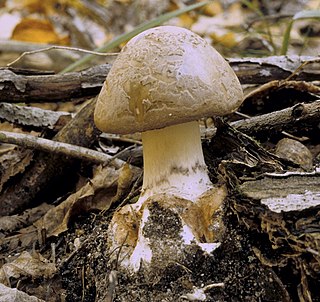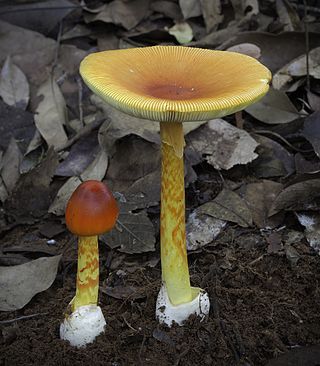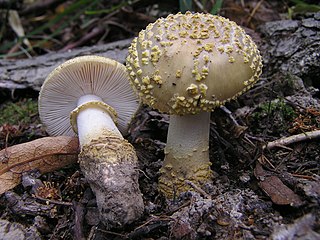
The genus Amanita contains about 600 species of agarics, including some of the most toxic known mushrooms found worldwide, as well as some well-regarded edible species. This genus is responsible for approximately 95% of the fatalities resulting from mushroom poisoning, with the death cap accounting for about 50% on its own. The most potent toxin present in these mushrooms is α-Amanitin.
Amanita altipes, also called the yellow long-stem amanita, is a species of agaric fungus found on soil in coniferous and broadleaved woodland in southwestern China up to an altitude of 4,000 metres (13,000 ft). The specific epithet altipes means "referring to the long stipe", and it suits the species as it has a longer stipe compared to its relatives.
Amanita parvipantherina, also known as the Asian small panther amanita, is a species of agaric restricted to Yunnan province in China. It is strongly associated with the Yunnan Pine Pinus yunnanensis. It fruits in July and August.

Amanita brunnescens, also known as the brown American star-footed amanita or cleft-footed amanita is a native North American mushroom of the large genus Amanita. Originally presumed to be the highly toxic Amanita phalloides by renowned American mycologist Charles Horton Peck, it was described and named by George F. Atkinson of Cornell University. He named it after the fact that it bruised brown. It differs from the death cap by its fragile volva and tendency to bruise brown. It is considered probably poisonous.

Amanita subjunquillea, also known as the East Asian death cap is a mushroom of the large genus Amanita, which occurs in East and Southeast Asia. Potentially deadly if ingested, it is closely related to the death cap A. phalloides.

Amanita vaginata, commonly known as the grisette or the grisette amanita, is an edible mushroom in the fungus family Amanitaceae. Unlike many other Amanita mushrooms, A. vaginata lacks a ring on the stem. The cap is gray or brownish, 5 to 10 centimetres in diameter, and has furrows around the edge that duplicate the gill pattern underneath. It has a widespread distribution in North America, and is thought to be part of a species complex that includes other similar-looking Amanitas.

Amanita hemibapha, commonly known as the half-dyed slender Caesar, is a species of agaric found in southeast Asia and Oceania, although some distribution reports may refer to different taxa.

Amanita exitialis, also known as the Guangzhou destroying angel, is a mushroom of the large genus Amanita. It is distributed in eastern Asia, and probably also in India where it has been misidentified as A. verna. Deadly poisonous, it is a member of section Phalloideae and related to the death cap A. phalloides. The fruit bodies (mushrooms) are white, small to medium-sized with caps up to 7 cm (2.8 in) in diameter, a somewhat friable ring and a firm volva. Unlike most agaric mushrooms which typically have four-spored basidia, the basidia of A. exitialis are almost entirely two-spored. Eight people were fatally poisoned in China after consuming the mushroom in 2000, and another 20 have been fatally poisoned since that incident. Molecular analysis shows that the species has a close phylogenetic relationship with three other toxic white Amanitas: A. subjunquillea var. alba, A. virosa and A. bisporigera.

Amanita magnivelaris, commonly known as the great felt skirt destroying angel or the great feltskirt destroying angel amanita, is a highly toxic basidiomycete fungus, one of many in the genus Amanita. Originally described from Ithaca, New York, by Charles Horton Peck, it is found in New York state and southeastern Canada.

Amanita franchetii, also known as the Franchet's amanita, is a species of fungus in the family Amanitaceae. It was given its current name by Swiss mycologist Victor Fayod in 1889 in honor of French botanist Adrien René Franchet. A. franchetii occurs in Europe and North Africa with oaks, chestnuts, and pines.

Amanita pekeoides is a species of fungus in the family Amanitaceae. It was first described scientifically by New Zealand mycologist Geoff Ridley in 1991.

Amanita volvata, also known as volvate amanita is an inedible white-coloured species of fungi from the family Amanitaceae found in the southeastern United States. Can be confused with Amanita ponderosa, but that species is from the Iberian peninsula. The species is amyloid and have saccate volva, and elliptic spores.

Amanita fuliginea, commonly known as the east Asian brown death cap, is a species of deadly poisonous mushroom in the family Amanitaceae. It was described as new to science by Japanese mycologist Tsuguo Hongo in 1953. Fruit bodies have convex, dark gray to blackish caps measuring 3–6 cm (1.2–2.4 in) in diameter. The gills, largely free from attachment to the stipe, are white and have short gills (lamellulae) interspersed. The spores are roughly spherical, amyloid, and typically measure 8–11 by 7–9.5 µm. The mushroom is common in China, where it has caused poisonings, a review of cases in southern China finding it had been responsible for the poisoning of 352 people, 79 of which died, between 1994 and 2012.

Amanita excelsa, also known as the European false blushing amanita, is a species of agaric fungus in the family Amanitaceae. It is found in Asia, Europe, and North America, where it grows in deciduous forests.
Amanita pallidorosea is a mushroom of the large genus Amanita, which occurs under beech and pine in China and Japan. It is closely related to the destroying angel A. bisporiga.
Amanita subpallidorosea is a mushroom of the large genus Amanita, which occurs under oaks in southern China and Taiwan. It is closely related to the destroying angel mushrooms A. virosa and A. ocreata.
Amanita subfuliginea is a mushroom of the large genus Amanita, which occurs central and southern China. It is closely related to the east Asian death cap A. fuliginea.
Amanita griseorosea is a mushroom of the large genus Amanita, which occurs under beech in southern China. It is closely related to A. molliuscula.
Amanita molliuscula is a mushroom of the large genus Amanita, which occurs under beech in Shaanxi Province in China. It is closely related to A. griseorosea.











